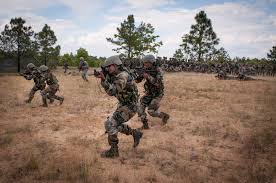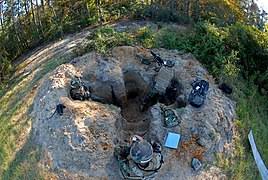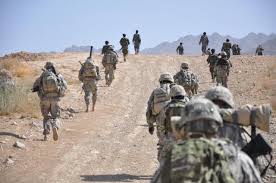
Whenever a mutual aid or preparedness group gets together for training, it almost always revolves around firearms skills. I wanted to take a few minutes and give some ideas for some basic things that are overlooked in a lot of group training programs.
The Ultimate Tactical Handbook instructs us to train for war:
It was only in order that the generations
of the people of Israel might know war,
to teach war to those who had not known it before.
Judges 3:2
There are many other skills that are just as important, aside from just shooting and weapons handling.
Obviously, first aid and communications are topics most groups do work on, in addition to shooting, but I want to focus here on the over-looked items.
TEAM MOVEMENT
I’ve attended a lot of training at Blackwater/US Training Center/Academi, or whatever they are calling themselves this week. When you go to the Executive Protection course there, the first 7 days are done without any firearms, because learning to move and drive in a formation is more important than shooting skills.
There is a lesson in there. Spend lots of days with your group learning to move in basic infantry formations, including how to fill and flow between them. At USMC Recruit Field Training Duty (second phase for my fellow Devil Dogs), you spend days walking tactical formations and learning to walk them together, flowing from one formation to another. At BlackWater it was the same, days of walking and driving in various formations so that your team can flow from one to the next without verbal communication.
It’s an important skill, and often overlooked, beyond the basic squad file. Learn team size (3-4 people) wedges, vee’s, echelons (both sides), line formations, skirmishers (both left and right), as well as the rationale for using them. Then learn them at the squad level. Resources include the US Army “Infantry Squad & Platoon” or the USMC “Marine Rifle Squad” manuals.

INDIVIDUAL FIGHTING POSITIONS
Another overlooked area is building an individual fighting position. Let’s be honest…We don’t train on this because we are LAZY and it’s not cool-guy stuff. In all honesty though, it can save your life. Everyone wants to do cool-guy stuff, like “CQB” (which they really aren’t learning), or “Room Clearing” drills, which really have less application to preparedness and survival than actually building a defensive position does.
Think about that…We claim to be preparing to defend our homes or bug-out locations, but most often we only focus on offensive skills.
Learning how to build and effectively camouflage an individual fighting position is hard work that will pay off far more in the real world than learning how to “Take City Hall” ever will.

SECURITY PATROLLING
Security Patrolling entails a team conducting a recon around your location, looking for signs of human activity or potential observation by an adversary.
Your team should learn to conduct zone recon, area recon, and successive sector recon patrolling.
It’s a great way to also practice the formations you learned earlier.
Patrolling is far more than just learning to walk in the woods. Hand signals, formations, actions at halts, immediate action drills, all need to be learned and incorporated.
The ability to send a SALUTE report could be invaluable (Size/Activity/Location/Unit/Time/Equipment) to providing early warning.
Then Joshua secretly sent two spies…
…”Go, look over the land”…
Joshua 2:1
If Joshua sent out recon patrols, you probably should ,too.

ENTRY CONTROL POINT/TRAFFIC CONTROL POINT OPERATIONS
If we’re truly about defending our neighborhood or group bug out location, wouldn’t setting up an Entry Control Point at the entrance be a great skill to work on? When was the last time your ultra tacti-cool militia group trained on it?
Learning the proper way to establish, secure, and operate an entry control point could be invaluable and yet folks don’t do any training on it.
The outstanding book, “Tactical Manual – Small Unit Tactics” by Max Velocity Tactical (www.maxvelocitytactical.com) has a section on this topic, as well as all the others I’ve discussed here.
But we prayed to our God
And posted a guard day and night
To meet this threat.
Nehemiah 4:9
Nehemiah knows what’s up…ECP’s.

IMMEDIATE ACTION DRILLS
The veterans out there know what I’m talking about. Immediate Action Drills are basic actions that units should automatically take when a particular situation happens.
As an example, React to an Ambush is a drill you would do to, well, react to an ambush.
Drills to cover are:
1. React to Ambush (near and far)
2. React to Indirect Fire
3. Hasty Ambush
4. React to Contact (in every direction)
5. React to Air Threat
The same resource manuals (US Army/USMC/Max Velocity) contain all these standardized drills.
A caution though…a lot of veterans are tempted to opt out of these…Don’t let them. While they know how to run the drills, they need to learn how to do them WITH YOUR TEAM. It’s a different dynamic with every team you move into.
RECAP
As you look over the list, it’s easy to say, “But those are the most basic combat tasks”…battles are won by basics. Get over the cool-guy worship and ultra tacti-cool hype, this is where battles are won.

All of the instructors at PKSA Karate (www.pksa.com) train once a month with Grand Master Dale Drouillard, the first American to ever receive a Tang Soo Do black belt (he also presided over Chuck Norris’ master test here in Michigan). He has been training in martial arts for over half a century and he begins every day with front punches & front kicks, like a white belt. There’s a lesson in there.
Consider the US Navy SEALS. They aren’t the best in the business because of ultra-secret tactics or the cool way they roll up the cuff of their sleeves (and why is every police department on the planet copying that stupid practice)…they’re best because they drill constantly ON THE BASICS.
Notice also that this list involves skills you can practice without expending a single round of ammunition. That’s by design, especially now that ammo is increasingly scarce.
I hope this helps trigger some new thinking among mutual assistance groups and gives you some great ideas.
Share any ideas below.
How can I reach JD to inquire about training opportunities?
LikeLike
Email me at Joedolio@protonmail.com
LikeLike